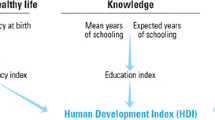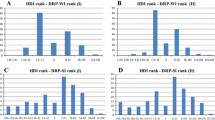Abstract
This paper proposes a new Human Development Index (HDI) classification method using as a basis the same dimensions and weights used by United Nations Development Programme (UNDP), however, avoiding the compensatory effect and misclassification that can occur when UNDP approach is applied. The proposed approach also allows working with any set of dimensions and weights. The classification was performed by the Elimination Et Choix Traidusaint la Realite (ELECTRE TRI), a multicriteria method, in which classes were defined with the visual aid of a non-parametrically tool, the Kernel Density Estimation and the class profiles were calculated by the Jenks Natural Breaks algorithm. The proposed classification method achieved better results than the one adopted by the UNDP, because the countries could be classified accurately in their natural classes without occurring the compensation effect. However, when comparing with the HDI index we have obtained an accuracy of 76.60% for the first proposed model and 78.72% for the second one. Our proposal purely used the same dimensions and weights adopted by UNDP. The proposed method is more robust, closer to reality and can eliminate the compensatory effect between dimensions, thus it can provide more credibility to the HDI. The combination of the ELECTRE TRI method with statistical tools to define classes and class profiles for the HDI is unprecedented in the literature.









Similar content being viewed by others
References
Alkire, S. (2002). Dimensions of human development. World Development, 30(2), 181–205.
Berenger, V., & Chouchane, A. V. (2007). Multidimensional measures of well-being: Standard of living and quality of life across countries. World Development, 35(7), 1259–1276. doi:10.1016/j.worlddev.2006.10.011.
Bilbao-Ubillos, J. (2012). Another approach to measuring human development: The composite dynamic human development index. Social Indicator Research, 111(i.2), 473–484. doi:10.1007/s11205-012-0015-y.
Bluszcz, A. (2015). Classification of the European Union Member states according to the relative level of sustainable development. Quality & Quantity. doi:10.1007/s11135-015-0278-x.
Booysen, F. (2002). An overview and evaluation of composite indices of development. Social Indicator Research, 59, 115–151. doi:10.1023/A:1016275505152.
Cherchye, Y., Ooghe, E., & Puyenbroeck, T. (2008). Robust human development rankings. Journal of Economy Inequality, 6, 287–321. doi:10.1007/s10888-007-9058-8.
Costa, H. G., Mansur, A. F. U., Freitas, A. L. P., & de Carvalho, R. A. (2007). ELECTRE TRI applied to costumers satisfaction evaluation. Produção, 17(2), 230–245. doi:10.1590/S0103-65132007000200002.
Craveirinha, J., & Clímaco, J. (2012). Multidimensional evaluation of the quality of life—A new non-compensatory interactive system. Relatório de Investigação Nº 6/2012, ISSN 1645-2631. INESC Coimbra.
Dowrick, S., Dunlop, Y., & Quiggin, J. (2003). Social indicators and comparisons of living standards. Journal of Development Economics, 70, 501–529. doi:10.1016/S0304-3878(02)00107-4.
Everitt, B. S., & Torsten, H. (2006). A handbook of statistical analyses using R. London: Chapman and Hall/CRC.
Grimm, M., Hattgen, K., Klasen, S., & Misselhorn, M. (2008). A human development index by income groups. World Development, 36(12), 2527–2546. doi:10.1016/j.worlddev.2007.12.001.
Hall, J. (2013). From capabilities to contentment: testing the links between human development and life satisfaction. In J. F. Helliwell, R. Layard, & J. Sachs (Eds.), World happiness report 2013. New York: UN Sustainable Development Solutions Network.
Hatefi, S. M., & Torabi, S. A. (2010). A common weight MCDA-DEA approach to construct composite indicators. Ecological Economics, 70, 114–120. doi:10.1016/j.ecolecon.2010.08.014.
Helliwell, J. F., Layard, R., & Sachs, J. (2015). World happiness report 2015. New York: Sustainable Development Solutions Network.
Jenks, G. F., & Caspall, F. G. (1971). Error on choropleth maps: definition, measurement, reduction. Annals (Association of American Geographers), 61, 217–244. doi:10.1111/j.1467-8306.1971.tb00779.x.
Klugman, J., Rodríguez, F., & Choi, H. J. (2011). The HDI 2010: New controversies, old critiques. The Journal of Economic Inequality, 9(2), 249–288. doi:10.1007/s10888-011-9178-z.
Martinez, E. (2013). Social and economic wellbeing in Europe and the Mediterranean Basin: Building an enlarged human development indicator. Social Indicator Research, 111, 527–547. doi:10.1007/s11205-012-0018-8.
Maziotta, M., & Pareto, A. (2015). Comparing two non-compensatory composite indices to measure changes over time: A case study. Statistika: Statistics and Economy Journal, 95(2), 44–53.
Morse, S. (2003). For better or for worse, till the human development index do us part? Ecological Economics, 45, 281–296. doi:10.1016/S0921-8009(03)00085-5.
Mousseau, V., & Slowinski, R. (1998). Inferring an ELECTRE TRI model from assignment examples. Journal of Global Optimization, 12(2), 157–174. doi:10.1023/A:1008210427517.
Noorbakhsh, F. (1998). A modified human development index. World Development, 26(3), 517–528. doi:10.1080/135048596355925.
Parzen, E. (1962). On estimation of a probability density function and mode. The Annals of Mathematical Statistics, 33(3), 1065–1076. doi:10.1214/aoms/1177704472.
Pinar, M., Thanasis, S., & Topaloglou, N. (2012). Measuring human development: A stochastic dominance approach. Journal of Economic Growth, 18(i.1), 69–108. doi:10.1007/s10887-012-9083-8.
Rosenblatt, M. (1956). Remarks on some nonparametric estimates of a density function. The Annals of Mathematical Statistics, 27(3), 832–837. doi:10.1214/aoms/1177728190.
Sagar, A. D., & Najam, A. (1998). The human development index: A critical review. Ecological Economics, 25, 249–264. doi:10.1016/S0921-8009(97)00168-7.
Salas-Bourgoin, M. A. (2014). A proposal for a modified human development index. CEPAL Review, pp. 29–44.
Smet, Y. D., Nemery, P., & Selvaraj, R. (2012). An exact algorithm for multicriteria ordered clustering problem. Omega, 40(6), 861–869. doi:10.1016/j.omega.2012.01.007.
Smith, M. J., Goodchild, M. F., & Longley, P. A. (2015). A comprehensive guide to principles, techniques and software tools (5th ed.). Leicester: Troubador Publishing Ltd. ISBN-13: 978-1906221522.
Tervonen, T., Lahdelma, R., Almeida Dias, J., Figueira, J., & Salminen, P. (2007). SMAA-TRI: A parameter stability analysis method for ELECTRE TRI. NATO Security through Science Series. doi:10.1007/978-1-4020-5802-8_15.
Trosset, M. W. (2011). An introduction to statistical inference and its applications with R. London: Chapman and Hall/CRC.
UNDP—United Nations Development Programme. (2016). Human Development Report 2015—Technical Notes. http://hdr.undp.org/sites/default/files/hdr14_technical_notes.pdf. Accessed 15 February 2016.
Wu, P. C., Wen, C., & Pan, S. C. (2013). Does human development index provide rational development rankings? Evidence from efficiency rankings in super efficiency model. Social Indicator Research, 116(2), 647–658. doi:10.1007/s11205-013-0285-z.
Zheng, B., & Zheng, C. (2015). Fuzzy ranking of human development: A proposal. Mathematical Social Sciences, 78, 39–47. doi:10.1016/j.mathsocsci.2015.09.002.
Zhou et al. (2010). Weighting and aggregation in composite indicator construction: A multiplicative optimization approach. Social Indicator Research, 96, 169–181. doi:10.1007/s11205-015-1157-5.
Author information
Authors and Affiliations
Corresponding author
Rights and permissions
About this article
Cite this article
do Carvalhal Monteiro, R.L., Pereira, V. & Costa, H.G. A Multicriteria Approach to the Human Development Index Classification. Soc Indic Res 136, 417–438 (2018). https://doi.org/10.1007/s11205-017-1556-x
Accepted:
Published:
Issue Date:
DOI: https://doi.org/10.1007/s11205-017-1556-x




